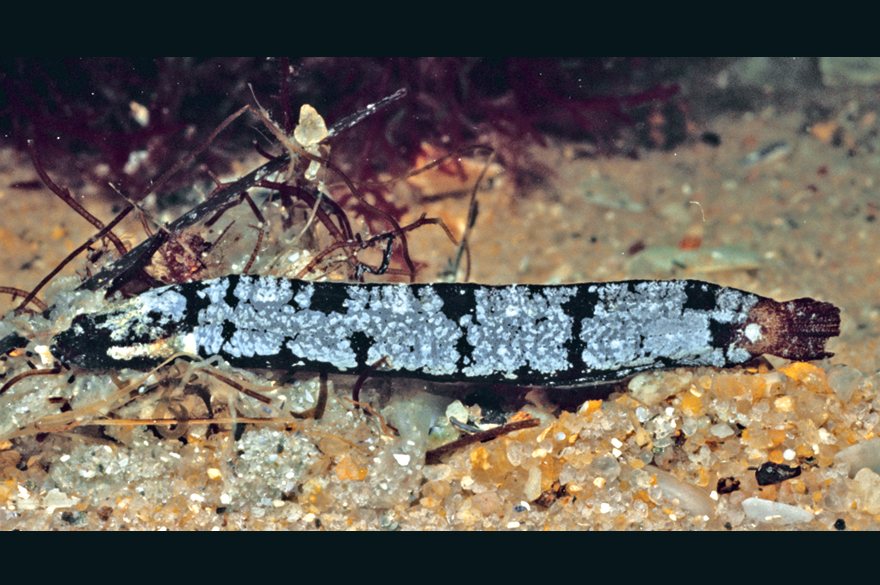Variegated Snake Blenny, Ophiclinops varius (McCulloch & Waite 1918)
Other Names: Variegated Snake-blenny

Variegated Snake Blenny, Ophiclinops varius. Source: Rudie H. Kuiter / Aquatic Photographics. License: All rights reserved
Summary:
A dark brown to black snake blenny with extensive white to grey diffuse patches on the top of the head and sides extending onto the fins, a diffuse broad white horizontal stripe behind each eye, and a brown caudal peduncle and caudal fin. The Variegated Snake Blenny often resembles seagrass detritus.
Cite this page as:
Bray, D.J. 2019, Ophiclinops varius in Fishes of Australia, accessed 01 Jul 2025, https://fishesofaustralia.net.au/Home/species/13
Variegated Snake Blenny, Ophiclinops varius (McCulloch & Waite 1918)
More Info
|
Distribution |
Wilsons Promontory, Victoria, and northern Tasmania, to the Recherche Archipelago, Western Australia. Inhabits tidepools, intertidal and shallow subtidal reefs, sheltering under rocks, amongst Amphibolis seagrass roots, weed and leaf detritus on sandy areas beside seagrass beds and reefs. |
|
Features |
Dorsal fin XL-XLV, 1; Anal fin II, 27-29; Caudal fin 12-14; Pectoral fin 6-10; Pelvic fin 1, 2. Body shallow (11-13% SL). Head small (19-21% SL); eyes small (21-23% HL); upper jaw length 33-34% HL., single dorsal fin arising slightly behind and above opercular edges; caudal fin rounded. Pectoral fins very small, length slightly less than eye diameter. |
|
Etymology |
The specific name varius (= variable) presumably refers to the irregular dark lines and dots on body, described as “variable and may be absent” |
|
Species Citation |
Ophiclinus varius McCulloch & Waite 1918, Rec. S. Aust. Mus. 1(1): 57, fig. 30. Type locality: Kangaroo Island, South Australia. |
|
Author |
Bray, D.J. 2019 |
|
Resources |
Variegated Snake Blenny, Ophiclinops varius (McCulloch & Waite 1918)
References
George, A. & Springer, V.G. 1980. Revision of the clinid fish tribe Ophiclinini, including five new species, and definition of the family Clinidae. Smithsonian Contributions to Zoology 307: 1-31 figs 1-14 https://doi.org/10.5479/si.00810282.307 open access
Hutchins, J.B. 2005. Checklist of marine fishes of Recherche Archipelago and adjacent mainland waters, pp. 425-449, in Wells, F.E., Walker, D.I. & Kendrick, G.A. (eds). Proceedings of the Twelfth International Marine Biological Workshop: The Marine Flora and Fauna of Esperance, Western Australia. Perth : Western Australian Museum.
Kuiter, R.H. 1993. Coastal Fishes of South-eastern Australia. Bathurst : Crawford House Press 437 pp.
Last, P.R., Scott, E.O.G. & Talbot, F.H. 1983. Fishes of Tasmania. Hobart : Tasmanian Fisheries Development Authority 563 pp. figs.
McCulloch, A.R. & Waite, E.R. 1918. Some new and little known fishes from South Australia. Records of the South Australian Museum (Adelaide) 1(1): 39-78 figs 26-31 pls 2-7 See ref at BHL
Rennis, D., Hoese, D.F. & Gomon, M.F. 1994. Family Clinidae. pp. 741-775, figs 650-684B in Gomon, M.F., Glover, C.J.M. & Kuiter, R.H. (eds). The Fishes of Australia's South Coast. Adelaide : State Printer 992 pp. 810 figs.
Williams, J.T., Holleman, W. & Clements, K.D. 2014. Ophiclinops varius. The IUCN Red List of Threatened Species 2014: e.T179027A1561076. http://dx.doi.org/10.2305/IUCN.UK.2014-3.RLTS.T179027A1561076.en. Downloaded on 23 July 2018.





